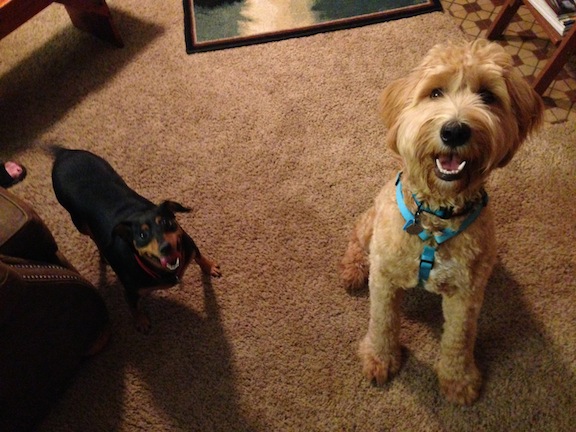Axel and Guss Learn Some Manners
By: David Codr
Published Date: July 18, 2013
Meet Axel a three year old Min Pin / Daschund mix (left) and Gus, a six-month-old Golden Doodle.
Their owner had contacted me to help them resolve several issues; Guss’s barking, jumping up on guests and not listening very well. Axle’s problems included not coming when called and nipping or throwing tantrums whenever people arrived or moved around in the home.
When I arrived, both dogs were in the backyard so I didn’t get to see how they typically greets guests, however their owner had give me a pretty detailed description on the phone.
When the dogs were let inside they both barked at me, but from a distance. This is typically a behavior that is exhibited by dogs that are either anxious, fearful or lack confidence.
I sat down with their owners so we could discuss the situation as well as what they wanted to accomplish in the session.
As I usually do, I asked what rules were in place to govern the dog’s day-to-day lives. I could see the light bulb appearing over their owners heads as they chuckled and said there weren’t really any rules in place.
Nine times out of 10, when I’m called in to help with dog behavioral issues, their owners have failed to give the dogs any rules, boundaries or limitations. Since dog’s thrive on clear rules and boundaries in a pack structure, one of the first steps in rehabilitating a dog or putting an end to it problematic behavior is to initiate some clear rules.
I suggested that their owners not allow the dogs on the furniture for a 30 day period of time. Since the height at which a dog sits has a correlation to its status in the pack, the simple act of denying the dogs a higher seating position helps elevate their owners into a leadership status while helping the dogs see themselves as followers.
To further increase their owners role as pack leaders, I demonstrated a leadership exercise that requires the dog to wait for permission before being rewarded. I started out with Guss as he was the younger dog and the dog that the owner said was more out of control. It took a few minutes before he “got it” but once he did, he eagerly participated in the exercise.
I coached his owners through the exercise a few times until they were comfortable doing it on their own, then we switched dogs and repeated the exercise with Axel. Axel understood what we were doing much faster than Guss, likely a result of his being older and being able to observe me walking across and his owners through the exercise.
I suggested that their owners repeat this exercise on a daily basis and gradually increase the amount of time that they require the dogs to sit and wait before it receives its reward. It’s always a good idea to gradually ramp up any exercise that requires longer periods of time, as it gives the dog the ability to gradually become accustomed to it and build up their ability to self restrain.
Since their owners have been free-feeding the dogs, I suggested that they change to a more structured and regimented feeding regimen. The order in which dogs eat in a pack also correlates to their status. Because the humans were feeding the dogs before they ate themselves, they were sending a mixed message to their dogs.
I suggested that they start eating in front of the dogs while food was in the dog’s bowls but making the dogs wait for permission to start to eat. This simple change to the feeding routine will also help the dogs see their human counterparts as leaders.
Neither of these dogs have extreme behavioral issues, they just needed someone to help them understand their position in the pack. By adding structure to their meals, adding some minor rules to their day-to-day lives and practicing the leadership exercise, this pack of dogs will learn to defer to their humans and respect them as their pack leaders.
Categorized in: Uncategorized




